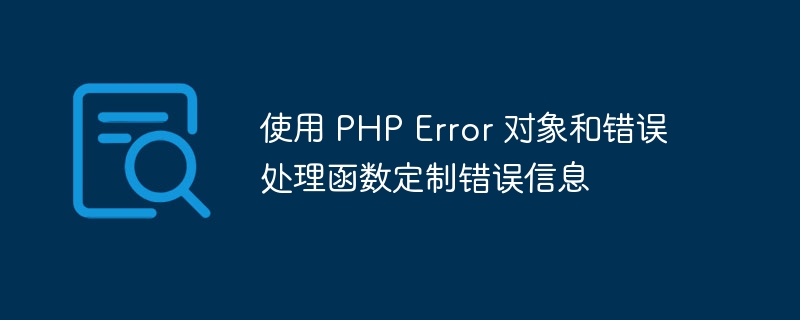Home >Backend Development >PHP Tutorial >Customize error messages using PHP Error objects and error handling functions
Customize error messages using PHP Error objects and error handling functions
- WBOYWBOYWBOYWBOYWBOYWBOYWBOYWBOYWBOYWBOYWBOYWBOYWBOriginal
- 2023-08-09 18:15:281446browse

Title: Customizing error messages using PHP Error objects and error handling functions
Text:
In PHP development, error handling is very important In part, it can help developers quickly locate and solve potential problems. PHP provides the Error class and a series of corresponding error handling functions, allowing us to customize our own error messages and perform corresponding exception handling.
In PHP, errors are divided into three levels: fatal errors, warnings and prompts. Each level has a corresponding error handling function to handle errors of different levels. We can use these error handling functions to customize error messages and handle errors.
First, we need to use PHP’s built-in Error class to create an error object. You can use the following code to create an error object:
$error = new Error("这是一个自定义的错误信息", 404);The first parameter is the customized error message, and the second parameter is the error code. This way we get a custom error object.
Next, we can use the error handling function to handle errors. There are three different levels of error handling functions, namely:
- ##trigger_error()
: used to handle fatal errors - user_error()
: Used to handle warning level errors - trigger_error()
: Used to handle prompt level errors
function myErrorHandler($errorCode, $errorMessage)
{
echo "自定义错误处理函数:{$errorCode} - {$errorMessage}";
}
set_error_handler("myErrorHandler");In the above example, we used the set_error_handler() function to set a custom error handling functionmyErrorHandler(). This function accepts two parameters, error code and error message. We customize how to handle errors in the function and output the error information.
ErrorException class to get more error information when catching exceptions. For example:
try {
// 一些可能触发错误的代码
} catch (ErrorException $error) {
echo "捕获到一个异常:{$error->getMessage()}
";
echo "在文件 {$error->getFile()} 的第 {$error->getLine()} 行发生错误";
}In the above example, we have used try and catch blocks to catch exceptions. When an error occurs, PHP will throw an ErrorException exception. We can obtain the exception information through the code in the catch block and handle it accordingly.
The above is the detailed content of Customize error messages using PHP Error objects and error handling functions. For more information, please follow other related articles on the PHP Chinese website!

